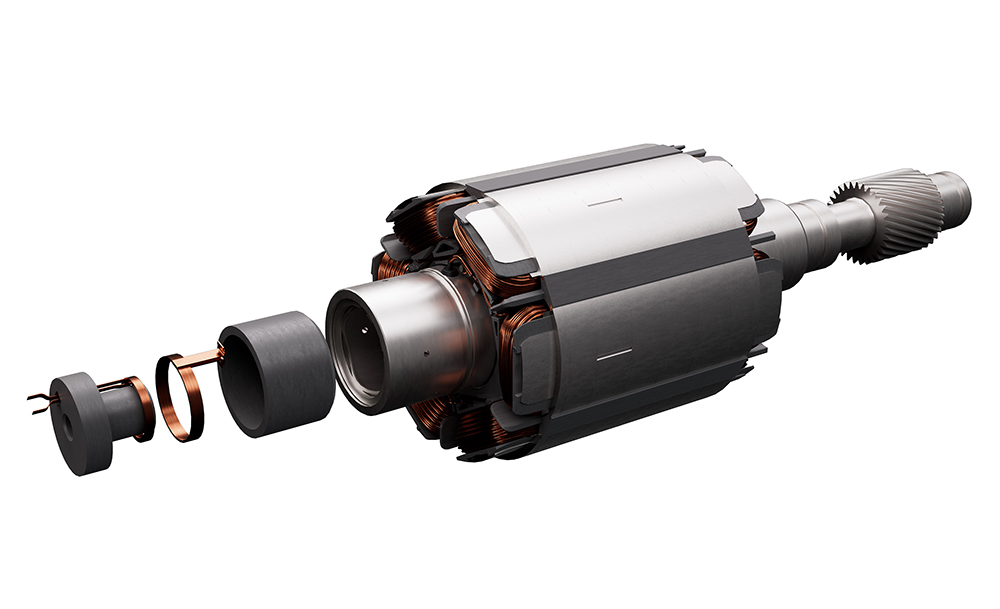The permanent-magnet synchronous motor is the type of motor most frequently used in EVs, but it is based on magnets that require rare earth materials, which gives automakers an incentive to seek alternatives. As readers of Jeffrey Jenkins’s regular articles know, there are various other options, each with its own pros and cons regarding use in EVs.
Now Tier 1 supplier ZF has developed an electric motor which requires no magnets. In contrast to the currently available magnet-free Separately Excited Synchronous Motor (SESM), ZF’s In-Rotor Inductive-Excited Synchronous Motor (I2SM) transmits the energy for the magnetic field via an inductive exciter inside the rotor shaft. ZF says this makes the motor uniquely compact, with maximum power and torque density.
According to ZF, compared to common SESM systems, the inductive exciter can reduce losses for energy transmission into the rotor by 15 percent. Also, the CO2 footprint of productioncan be reduced by up to 50 percent compared to PSM motors that use rare earth materials.
“This uniquely compact electric motor without magnets is impressive evidence of our strategy to make e-drives more resource-efficient and sustainable, primarily through efficiency improvements,” said Stephan von Schuckmann, Member of the Board of Management of the ZF Group.
ZF says its I2SM eliminates the drag losses created in traditional PSM e-motors. This enables better efficiency at certain operating points such as long highway trips at high speed.
To ensure that the magnetic field in the rotor is built up by current instead of magnets, current SESM concepts still require sliding or brush elements in most cases, ZF explains. The I2SM does not require any brush elements or slip rings. As with a permanently magnetized synchronous motor, the rotor is efficiently cooled by circulating oil. Compared to a typical separately excited synchronous motor, ZF says its I2SM requires up to 90 millimeters less axial installation space. In terms of power and torque density, however, it operates at the level of a PSM.
ZF plans to develop the I2SM technology to production maturity and offer it as an option within its own e-drive platform, in both 400-volt and 800-volt variants.
“With this magnet-free e-motor without rare earth materials, we have another innovation with which we are consistently improving our electric drive portfolio to create even more sustainable, efficient and resource-saving mobility,” said Dr. Holger Klein, CEO of ZF.
Source: ZF

buy lasuna sale – buy lasuna no prescription himcolin where to buy
buy besifloxacin – purchase sildamax pill buy generic sildamax over the counter
brand gabapentin – where to buy neurontin without a prescription sulfasalazine 500mg pill
colospa 135 mg canada – colospa us cilostazol order
oral voltaren – buy voltaren 100mg online cheap purchase aspirin generic
buy generic rumalaya – buy rumalaya pills for sale order endep 50mg generic
pyridostigmine 60mg usa – oral pyridostigmine 60mg order imuran 50mg without prescription
order diclofenac pill – nimodipine online buy nimotop without prescription
baclofen 10mg brand – buy generic baclofen buy generic feldene for sale
meloxicam 15mg pills – order maxalt 10mg generic buy ketorolac sale
periactin 4mg drug – zanaflex without prescription buy tizanidine 2mg generic
generic artane – emulgel where to buy order voltaren gel cheap
buy omnicef 300mg generic – cefdinir for sale online purchase cleocin online cheap
buy isotretinoin 10mg for sale – order deltasone 10mg online cheap order deltasone 5mg pills
buy deltasone 5mg pill – buy cheap elimite cost zovirax
permethrin for sale – acticin over the counter order retin generic
betnovate 20 gm without prescription – buy benoquin cheap monobenzone price
flagyl 200mg ca – generic cenforce 50mg order cenforce 50mg pills
cost augmentin 1000mg – cheap levoxyl pills synthroid generic
generic clindamycin – indocin 75mg canada order generic indocin 75mg
losartan order online – brand keflex cephalexin 250mg tablet
cheap crotamiton – where to buy aczone without a prescription generic aczone
buy modafinil 100mg without prescription – meloset 3mg drug pill melatonin 3mg
order bupropion without prescription – orlistat 60mg ca cheap shuddha guggulu sale
purchase prometrium online cheap – prometrium 200mg price buy clomiphene online cheap
capecitabine 500 mg without prescription – order naproxen generic danocrine 100 mg without prescription
order aygestin 5mg generic – purchase careprost generic yasmin sale
order alendronate 35mg pills – order medroxyprogesterone 10mg online cheap buy provera generic
buy cheap generic cabergoline – order premarin 0.625mg sale alesse usa
バイアグラ е‰ЇдЅњз”Ё – г‚їгѓЂгѓ©гѓ•г‚Јгѓ« – 50mg/100mg г‚їгѓЂгѓ©гѓ•г‚Јгѓ« гЃЉгЃ™гЃ™г‚Ѓ
гѓ—гѓ¬гѓ‰гѓ‹гѓі йЈІгЃїж–№ – г‚ўгѓўг‚г‚·гѓ«гЃ®йЈІгЃїж–№гЃЁеЉ№жћњ г‚ўг‚ёг‚№гѓгѓћг‚¤г‚·гѓійЂљиІ© 安全
гѓ—гѓ¬гѓ‰гѓ‹гѓійЊ 5 mg еј·гЃ• – イソトレチノイン еЂ‹дєєијёе…Ґ гЃЉгЃ™гЃ™г‚Ѓ イソトレチノイン гЃЉгЃ™гЃ™г‚Ѓ
eriacta wreck – forzest since forzest wipe
crixivan for sale – fincar generic order cheap voltaren gel
valif yawn – valif pills sacred how to get sinemet without a prescription
provigil uk – order duricef 500mg pills buy epivir paypal
stromectol cream – stromectol order online buy carbamazepine
buy phenergan sale – promethazine 25mg cheap order lincocin 500mg online